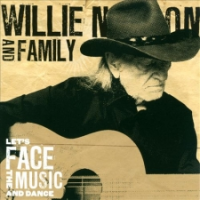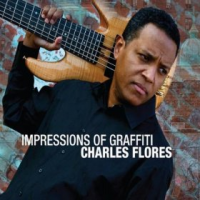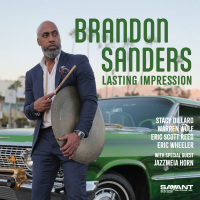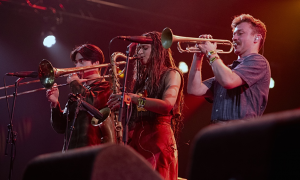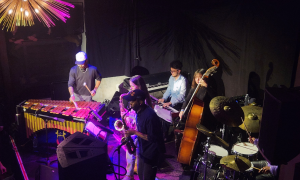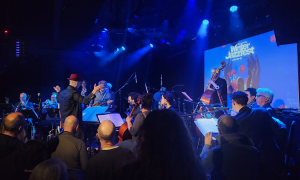Home » Jazz Articles » Live Review » Steven Wilson at Club Soda
Steven Wilson at Club Soda
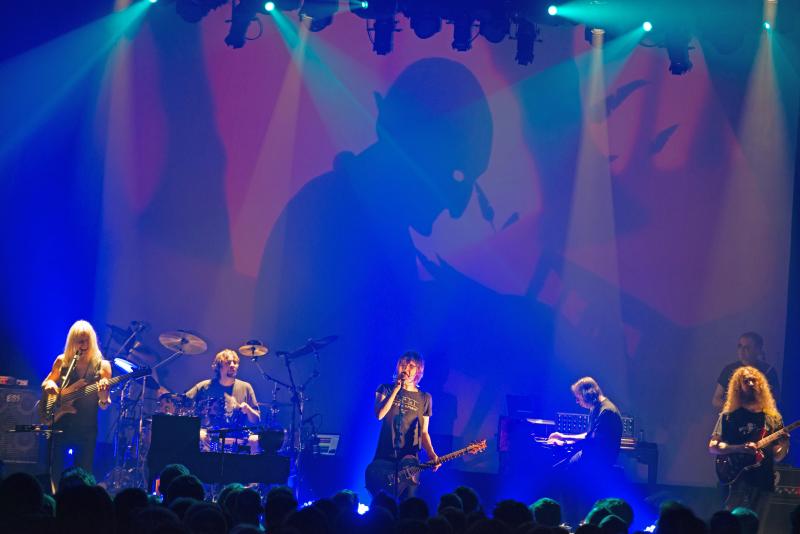
Club Soda
Montreal, Canada
April 25, 2013
When currently ex-Porcupine Tree founder/front man last played Montreal in November, 2011—touring in support of his second solo recording, Grace for Drowning (Kscope, 2011)—it was clear by the end of the performance that the next time he came to the Canadian city, the crowd which filled the 800-capacity Corona Theatre was certain to grow. Not exponentially, as Wilson's solo career has unveiled in a methodical fashion that is, for anyone who knows him, absolutely consistent with his personality. Wilson is undeniably a risk taker, but he's a careful one.
It may have been a risk to walk away from Porcupine Tree (at least, for the time being) to launch a solo career where, in his 2012 All About Jazz interview, he recounted how he'd been told by ex-Genesis guitarist Steve Hackett to ..."expect your audience to fall by 80 percent." At the time of the interview Wilson had already managed to buck the odds, managing to retain about 50 percent of his Porcupine Tree fans. Less than a year later, with the release of The Raven That Refused to Sing (And Other Stories) (Kscope, 2013) still fresh—and selling extremely well—that number is now more like 80 percent, and for a variety of reasons. No mean feat, considering he's in a more progressive arena than Porcupine Tree, writing material that blends deeper complexity with unmistakable lyrical appeal.
Wilson now has a band that, with the addition of guitarist Guthrie Govan to the pre-existing lineup of woodwind/reed multi-instrumentalist Theo Travis, keyboardist Adam Holzman, bassist/stick player/background vocalist Nick Beggs and drummer Marco Minnemann, is one of the best—if not the best—progressive rock groups on the road today, bringing a strong jazz sensibility to what is still undeniably a progressive rock show. And while he's still, for the most part, touring smaller venues than he did with Porcupine Tree, his audience is gradually building, and it's likely that, just as the Grace for Drowning tour grew his fan base, this year's extensive world tour will do the same...and, perhaps, even more.
For his return to Montreal, Wilson moved to the 940-capacity (standing) Club Soda, which was home to Jaga Jazzist's tremendous 2011 Montreal Jazz Festival performance, where the crowd's over-the-top response surprised a Norwegian jazz/prog group well-used to overzealous reactions. Montreal has long held a reputation for its particularly ardent audiences, and the sold-out Club Soda crowd didn't disappoint, responding to Wilson's show with so much enthusiasm—and so completely unwilling to let the group get away with just one encore—that Wilson decided to do something he's only done one other time on this tour: return for a second one.
The first encore was also something of a surprise, a version of Porcupine Tree's early, Pink Floyd-informed "Radioactive Toy," from 1991's On the Sunday of Life... (Delerium). Wilson explained that since the first three recordings were really solo recordings (not forming a touring band until he needed one a few years later), he figured it was fair game to include a song from that repertoire. True enough, but a second encore medley of Grace for Drowning's "Remainder the Black Dog" and Insurgentes' "No Twilight Within The Courts Of The Sun"—its unusual segue between tunes explained away by Wilson backstage after the show as, "there's no easy way to get from 15 to 21," referring to the two songs' irregular meters—only demonstrated, in very clear terms, just how far Wilson has come as a writer since those early days, from 1988-1991, when he conceived, wrote and recorded that important first album.
Montreal's outrageously enthusiastic response to Wilson's show was not without extreme good reason; if his 2011 show was superb, his April 25, 2013 Club Soda performance was even better, an intense, dramatic show filled with epic writing, memorable melodies and stellar playing. The group has clearly come a long way in 17 months in terms of chemistry, comfort and trust, but it's the addition of Govan that has finally completed Wilson's band; a guitarist as compelling, capable, imaginative and dynamic as the rest of his band mates, it's the final piece of a puzzle Wilson has been creating since he first toured Grace for Drowning two years ago.
The tour hasn't been without its upsets: after committing to Wilson's tour, Minnemann announced, not long before it was to commence earlier this year, that he'd be unable to make the North American leg of the tour. There was no shortage of outrage at the heavily populated progressive rock forum Progressive Ears, one thread actually titled Steven Wilson North American Tour WITHOUT Marco Minnemann!!!!. Wilson managed to find a more than suitable replacement in Chad Wackerman—a Frank Zappa and Allan Holdsworth alum who, while not necessarily sharing Minnemann's inherent chemistry with the rest of the group, would certainly have brought something of his own to the group. Called home unexpectedly to deal with an urgent family health matter, the good news is that Minnemann was available to handle the North American dates until Wackerman can return, and so Montreal was treated to a performance by the full band that recorded The Raven.
As strong as Wackerman would have been (and, if he is able to return, undoubtedly will be), the fact is that, for the first time since going solo with Insurgentes (Kscope, 2009), Wilson has written an album with this specific lineup in mind, and so changing any component was destined to alter its complexion. With Minnemann demonstrating his usual uncanny ability to drive a groove with effortless and, at times, near-unbelievable virtuosity—never playing the same thing twice—he engaged the rest of the group with the same near-telepathic interplay that's become a touchstone for every member of the band, even newcomer Govan.
And, while Govan has clearly integrated fully with the band, both on record and in performance, he's still the relatively new kid on the block. Grace for Drowning's "Sectarian," for example, did not make its way into the nearly two and a half hour set list because he wasn't quite comfortable enough with it yet (but watch for it on later shows in the tour). That said, when the group ran It down during soundcheck, it sure seemed close to ready, with Holzman contributing a staggering Fender Rhodes solo that he'd be challenged to top (and did) later that evening. There's no denying that a group can be driven to greater heights by the reciprocal energy of an enthusiastic crowd, but it's also true that magical things sometimes happen during soundcheck, where a group can be more relaxed, with less to prove.
The set included The Raven in its entirety—though split up rather than performed as a complete and distinct entity unto itself—and a much greater focus on Grace for Drowning than Insurgentes, the main show only including two songs from Wilson's first solo record: the album-opening "Harmony Korine" and album-closing title track. Wilson demonstrated that, even though The Raven seemed to be immovably perfect in its running order, live performance is a different beast entirely, with completely different requirements when it comes to creating a set list that builds its own dynamic and arc. Wilson did open with The Raven's first two tracks back-to-back—the episodic "Luminol," combining fusion-esque soloing (from Holzman, Travis and Govan) and symphonic grandeur, and the more pastoral, song form of "Drive Home," which still left room for another jaw-dropping solo from Govan—at one point casually replacing his slide back on his amp with one hand, while the other continued its light-speed legato lines. A 41 year-old guitarist who has made his name largely in the arena of education, providing columns and instructional CDs/DVDs for a variety of guitar magazines, his star should certainly rise even further as a consequence of joining this group, and with his instrumental power trio with Minnemann, The Aristocrats, soon to release its second album.
As ever, the sound was impeccable thanks to front of house engineer Ian Bond, also back from the last tour and demonstrating both Wilson's loyalty and desire for consistency. The Corona Theatre review went into great detail about how Wilson manages to put on a large scale-looking show on a budget, and the same applied here, with an iPad app allowing his guitar tech to adjust monitor levels on the main soundboard, eliminating the need for side of stage monitor engineer. Unusually, Bond also travels with his own board—a small but sophisticated console that renders the need for traditional, massive multi-channel boards with rows upon rows of sliders obsolete, its relatively small number of sliders deceptive until it becomes clear that there's another panel of buttons, one for each musician; when "Marco" is pressed, the sliders control the drummer's inputs, while pressing "Guthrie" switches them over to the guitarist's various microphones and direct lines in.
Wilson doesn't think of live performances as merely musical; instead, he views them as multimedia events where the show begins before the band hits the stage and continues after the group makes its final curtain call. This time, with music and a subtly shifting image on the stage's rear screen commencing 30 minutes before show time and concluding 15 minutes afterwards, the idea was, again, to subliminally draw the audience to a place distanced from their normal lives before the show began and allow them to gradually return to it after the last encore was played.
Like Bond, Paul Vd Heijk was also back to handle the lighting and rear projection screen. He may not have appeared to be doing much during the show, but that's because he'd programmed his lighting to synch with backing tracks which provided additional vocals and instrumentation to the group, allowing for a more accurately reproduction of the recordings' rich sound worlds. Van de Heijk did do "live" lighting in a couple of instances, but for the most part, his work was done in pre-production and during the setup in each venue, rendering his task, during the actual show, as more of a monitor to ensure nothing went wrong (it didn't). The lighting, combining floor lights that travel with the band in concert with whatever lighting the venue provides (and it's different every night, he says), was superb—bold at times, more subtle at others—and, combined with background images including Hajo Müller's artwork from the Deluxe Edition of The Raven, and Lasse Hoile's video imagery from Grace for Drowning, the show was as compelling to see as it was to hear.
Wilson used programmed backing tracks that included a lot of layered vocals, many coming from the back of hall speakers that provided a surround sound experience for the audience. There are those that frown upon such use but, in truth, this is not uncommon practice—even in the jazz world, where guitarist Pat Metheny regularly used both backing and, for his band, guide tracks in the monitors when he toured with Pat Metheny. While it might seem that such tracks could detract from the spontaneity of Wilson's performance, nothing could be further from the truth: this is absolutely a live band—one which may follow strict compositional and arrangement road maps from night to night, but which, within those confines, interprets the songs differently at each and every performance.
Wilson's voice seemed stronger than in 2011, and he was far more engaged with the audience, speaking far more often to them between songs. As always, Wilson's vocal delivery was about the words and not the kind of melisma that now pervades pop music. As a guitarist and keyboardist, Wilson may not be on the same level as his band mates, but when he did solo, as he did on a particularly beautiful version of Grace for Drowning's "Deform to Form a Star," it was with faultless taste, and has been raised by association. He may not possess his band's instrumental sophistication but, during an afternoon coffee hang with Travis, Hoizman and Beggs, all three musicians were quick to point out that, yes, they're all strong players, but without Wilson's writing, the band would simply not be what it is, as it continues to evolve and expand its purview. Holzman made a particularly important point when he explained how, by the time the second or third week of a tour rolls around, bands more often than not feel like they've reached the pinnacle and there's not a whole lot more to say; with this band, already well into the tour, the same degree of excitement and sense of discovery continues to happen, each and every night.
That this is not just a bunch of pickup musicians but a real band is what makes its live performances often surpass the studio originals. Admittedly, they're two different beasts—and with The Raven there's a closer proximity, since it was recorded old school, the band laying down one track, live off the studio floor, each day for six days, with legendary engineer Alan Parsons at the board, rather than today's norm of sending files around to musicians who may be together on an album but never actually play together. The 25 minute-plus "Raider II," inspired by the infamous BTK serial killer, has evolved into something far more intense and nightmarish than the studio version, while The Raven's closing title track, which also ended the main part of the show, has become more dramatic, more symphonic, and—with Müller's video imagery relaying its story of an old man whose sister died when he was young and, as he reaches the end of a life scarred by the event, tries to compel a raven in the woods to sing as his sister did when he was a child—even more heartbreaking.
It's impossible to single out anyone in the band, as everyone was absolutely at the top of their game: Beggs' playing was a combination of unshakable, ever-inventive anchor and imaginative virtuosity; Minnemann, a charismatic drummer who seems to be the happiest drummer this side of Joey Baron; Holzman, combining a love of vintage sounds with a modernistic, genre-busting approach that could move from from neo-classical to jazz-centric in a heartbeat; Travis, whether on tenor or soprano saxophone, flute, clarinet or bass clarinet, acting as both melodic foil and equally powerful soloist; and Govan, the biggest surprise only because he's new—a guitarist comfortable with a role ranging from broadly textural and contrapuntally melodic to thundering and riff-driven, all from an improviser with such a broad command that it was impossible to predict what was coming next.
Barefooted, Wilson roamed the stage, generously drawing attention to his band mates; this may be his band, his music and his vision, but he clearly knows that the very specific chemistry of these five instrumentalists are as essential to his success as his own contributions. Backstage after the show, Wilson talked about his current plans, and they continue to mirror what he said in his AAJ interview, eight months ago:
"For me, right now, the things that are really enjoyable are the solo project and continuing to work on remixing classic records. Those things have become the most enjoyable over the last three or four years. I never wanted to feel like that my career was becoming a machine, and the problem with the rock music world is that happens a lot—a lot of my friends are stuck in this tour-album, tour-album rut. That's not why I became a musician. I became a musician because I love making music, I love making different kinds of music, and I love making different kinds of music with different people and traveling and meeting people. That's what I love the most. Doing the remixing work has enabled me not only to work with a lot of people but also to meet and get to know a lot of the people who inspired me to make music in the first place. And doing the solo thing, for me, has been so inspiring, has made me confront a lot of my own habits and break patterns that I could easily have fallen into."
With a slew of remix projects done, in progress and being planned for a variety of bands, some of which will be no surprise, while others most certainly will (Wilson revealing that it takes him about ten days to do a stereo and surround mix for a 45-minute album), and with the rest of the year largely occupied by this work and the tour, Wilson's plate is plenty full. Will there be a live release of this tour? At this point: uncertain. What is clear is that Wilson's having the time of his life, and his superb performance at Montreal's Club Soda was just one more example of a career that continues to be on an upward trajectory. Beyond the usual over-fifty gray and no-hair T-shirted prog fans, there was a surprising number of younger fans and, for the prog world, an even more unexpected number of women.
Wilson is clearly succeeding in making progressive music with more than the usual appeal, even as he successfully manages to stay true to his vision with a group of musicians capable of making it an absolutely intense and exhilarating reality.
Photo Credit
John Kelman
Tags
steven wilson
Live Reviews
John Kelman
Canada
Montreal
Steve Hackett
Theo Travis
Adam Holzman
Jaga Jazzist
Chad Wackerman
Frank Zappa
Allan Holdsworth
pat metheny
Pat Metheny Group
Joey Baron
About Steven Wilson
Instrument: Composer / conductor
PREVIOUS / NEXT
Support All About Jazz
 All About Jazz has been a pillar of jazz since 1995, championing it as an art form and, more importantly, supporting the musicians who make it. Our enduring commitment has made "AAJ" one of the most culturally important websites of its kind, read by hundreds of thousands of fans, musicians and industry figures every month.
All About Jazz has been a pillar of jazz since 1995, championing it as an art form and, more importantly, supporting the musicians who make it. Our enduring commitment has made "AAJ" one of the most culturally important websites of its kind, read by hundreds of thousands of fans, musicians and industry figures every month.



